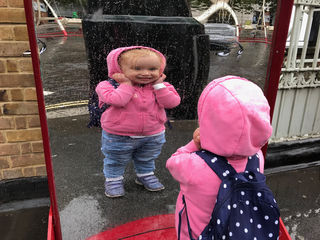At What Age to Babies Tend to Begin to Recognize Themselves in the Mirror?
Since the very outset time my son looked in a mirror, he was in love with what he saw: A beautiful and chubby little infant effulgent back at him. He turns his head back and forth and watches in delight as the baby in the mirror mimics his every move. He smiles and laughs and even tries to kiss himself. He never for a second seems to recognize that the baby in the mirror is simply his own reflection; instead, it is just another cute baby to play with.

Source: Matt Brown/Flickr
Recognizing their ain reflection isn't something that babies can do until around eighteen months of age. The first sign that babies recognize themselves in the mirror is from what researchers telephone call the "rouge examination." The test involves putting a bit of lipstick (or rouge if you were wearing makeup when the test was invented in the 1970s) on a babe'south olfactory organ and and so putting the baby in front of a mirror to observe his or her reaction. Before 18 months of historic period, babies evidence no signs of noticing the lipstick whatsoever; they smile at the babe in the mirror, only like my 8-month-old son does. Around a year and a half, their reactions start to look different. For the first time, the rouge-nosed babies look somewhat distressed and effort to rub the lipstick off their ain noses instead of playing with the cute babe in the mirror (Lewis, 1995).
It isn't clear why it takes babies 18 months to recognize themselves. It doesn't seem to thing how much experience they have looking in mirrors either; babies who have never seen a mirror earlier show the same pattern of responding when compared to babies who meet mirrors all the time (Priel, and de Schonen, 1986). And we know that they recognize that their faces are familiar in both photographs and videos by eight months of historic period, preferring to look at faces of a new babe than at their own confront (Bahrick and Moss, 1996).
Recognizing themselves in the mirror seems to be a bit more complicated, and involves beingness able to think well-nigh themselves as independent beings that have minds and thoughts that are split and distinct from yours or mine. This is of import, every bit information technology marks the ancestry of theory of mind. Theory of mind is the understanding that other people have thoughts and feelings that are separate from yours. Information technology is what allows children to empathise other people's intentions and emotions, and is related to a multifariousness of important prosocial behaviors, like sharing and helping, and potentially even deceptive behaviors like lying.
Chiefly, a sense of self is also related to the development of the self-conscious emotions like empathy, guilt, shame, embarrassment, and pride, which each crave a child to compare their own actions to the expectations of others. For case, for a kid to experience guilt, they accept to understand that something they have done might have caused someone else to exist upset or angry. Besides, to feel pride, he needs to understand that something he has done might elicit admiration from others. These emotions aren't more often than not observed in children until the second year of life after they've shown evidence of having a sense of self—after they've stopped trying to play with the baby in the mirror and have learned to recognize themselves in their reflections.
Mirror recognition (and the advanced cognitive and emotional abilities that come with it) isn't an easy feat, and in fact, few animals can recognize their own reflections in a mirror. Also humans, simply the nifty apes, some monkeys, and dolphins seem to be able to do it. It might be part of what makes us uniquely human. And although 18 months sounds similar an clumsily long time to exist clueless near the fact that you are that cute baby staring dorsum at yourself, it ways that past a year and a half, babies are already discovering that they have a unique place in the world, which sets the phase for the many new and heady discoveries that are yet to come.
References
Bahrick, 50. E., & Moss, L. (1996). Development of visual cocky-recognition in infancy. Ecological Psychology, 8(3), 189-208.
Lewis, Yard. (1995). Embarrassment: The emotion of self-exposure and evaluation. In J. P. Tangney & K. Westward. Fischer (Eds.), Cocky-conscious emotions: The psychology of shame, guilt, embarrassment, and pride (pp. 198-218). New York, NY, Usa: Guilford Press.
Priel, B., & de Schonen, S. (1986). Self-recognition: A study of a population without mirrors. Journal of experimental kid psychology, 41(2), 237-250.
Source: https://www.psychologytoday.com/us/blog/the-baby-scientist/202002/whos-baby-in-the-mirror
0 Response to "At What Age to Babies Tend to Begin to Recognize Themselves in the Mirror?"
Post a Comment